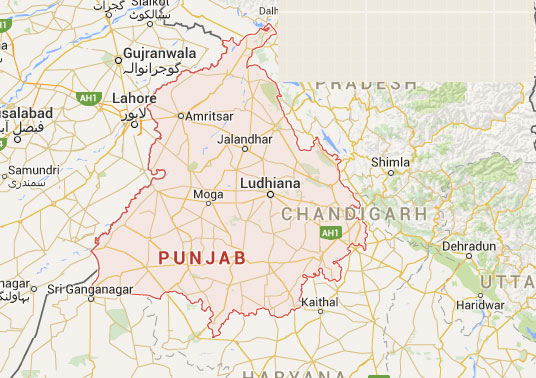
Punjab: Increasing Vulnerabilities
The responses to the Dinanagar Police Station attack were encouraging on many parameters. The challenge was quickly accepted by the first responders - the Punjab Police itself - and they were determined in their refusal to relinquish responsibility even after National Security Guard and Army reinforcements, with their vastly superior weaponry and training, arrived on the scene in strength; and the Punjab Police leadership led from the front. Nevertheless, there were obvious and visible deficiencies in protective gear, weaponry, training and fitness of the Police personnel responding, including those of the Punjab Police SWAT [Special Weapons and Tactics] team deployed, and an examination of various aspects of Police functioning in the wake of the attack exposed growing politicization, indiscipline, resource constraints and capacity deficits in the wider Policing apparatus of the State.
Compounding these factors is the manifest porosity of the elaborately fenced and patrolled border, and widespread allegations of political and Security Forces (SF) collusion in a rampant drug and smuggling trade that is also exploited by extremist and terrorist elements.
It is significant however, that despite these many deficits and defects, the Sikh extremism and terrorism that had ravaged Punjab in the late 1980s and early 1990s finds no resonance on the ground today. Indeed, the two major attacks that have been executed in the State in 2015-16 are the work of Pakistan-backed Islamist terrorists. This is despite the fact that Pakistan has done all it could have to keep the Khalistani movement alive, providing safe haven and funding to the surviving leadership and cadres in Pakistan, and also vigorously supporting and directing the activities of subversive elements across the world. Despite pressure from Pakistan's Inter Services Intelligence (ISI), however, these groups have failed to mount any significant operation on Indian soil in recent years. The last recorded major terrorist attack attributed to the Khalistanis in Punjab dates back to October 14, 2007, when seven persons were killed and another 40 were injured in a bomb blast inside a cinema hall in Ludhiana. While there has been no definitive identification of the group responsible, Police sources and contextual information suggest that this was the handiwork of a Sikh terrorist formation based in Pakistan.
There were no fatalities in terrorist violence in 2008-09, and a single incident, executed by the Lashkar-e-Taiba (LeT) on April 25, in 2010, in which two Pakistani terrorists were shot dead, and two Punjab Policemen were also killed, at Rattarwaha village in Gurdaspur District, bordering the Kathua District of Jammu & Kashmir.
Again, there were no incidents recorded between 2012 and 2014, and the peace was only shattered by the Pakistani terrorist attack at Dinanagar.
Nevertheless, efforts to keep Khalistani terror alive continue. Thus, between 2010 and 2015, at least 46 Khalistani terrorist modules, principally associated with the Babbar Khalsa International (BKI), Khalistan Liberation Force (KLF), Bhindranwale Tigers Force of Khalistan (BTFK), Khalistan Zindabad Force (KZF), Khalistan Commando Force (KCF), and some minor factions, were identified and neutralized, resulting in the arrest of at least 158 terrorists.
Intelligence sources indicate that the Khalistani leaders holed up in Pakistan are finding no volunteers for terrorist strikes in Punjab, and that some of these are now collaborating with the ISI to train Pakistani locals in the language and culture of Indian Punjab, and in the Sikh tradition, to facilitate their infiltration into, and operation in, the State. There have also been continuous efforts to engineer some kind of collaboration between Islamist terrorist formations and Khalistani formations in Pakistan for operations in India, but apart from occasional facilitation in the movement of weapons, explosives and cadres, this has not resulted in any significant operational cooperation.
These, in combination, are the likely reasons for a diversion of cadres of Pakistani terrorist formations such as LeT and Jaish-e-Mohammad (JeM) to Punjab in the Dinanagar and Pathankot attacks. These attacks also appear to indicate Islamabad's continued determination to destabilize, and to engineer a revival of militancy, in the State. The Dinanagar and Pathankot strikes may, consequently, be intended as demonstrations of the vulnerabilities in Punjab, and encouragement to Khalistani elements to take up the gun and the bomb again.
Pakistan's efforts continue to be backed by radical elements in the Sikh Diaspora, principally located across Europe and North America, with fragments in some countries of South East Asia as well. The Khalistani presence is significant in USA, Canada, UK, Germany, Norway, and Italy, where various groups continue to engage in propaganda, fundraising and recruitment for the Khalistani cause, and to orchestrate occasional protests and demonstrations.
While all these efforts have failed to secure traction on the ground within Punjab, Sikh radical activity has seen an escalation on the Internet and Social Media, as well as on a number of extremist owned Television Channels abroad. Funding from activists and sympathizers in the West has also resulted in the production of a number of inflammatory films in Punjabi, and these have been widely circulated in an effort to radicalize impressionable youth in Punjab.
These efforts are overlaid on increasing political frustration and disorders within Punjab, and a growing resentment against Chief Minister Prakash Singh Badal's regime, widely perceived as endemically corrupt. In October 2015, this frustration boiled over into obviously orchestrated protests and demonstrations over the desecration of copies of the Guru Granth Sahib, the Sikh holy book.
Earlier, hardline Sikhs had sought to mobilize for the commemoration of the anniversary of Operation Blue Star in June 2015, with their efforts within Punjab finding echoes across UK, France, Canada, Germany, Pakistan and Malaysia, among others.
The Police in Punjab have demonstrated that they retain the capacities to penetrate the surviving networks of Khalistani sympathizers and to scotch any efforts of revival. There is, nevertheless, the clear and present danger of direct engagement of Pakistan backed Islamist terrorists, who are evidently better motivated and organized. Moreover, given the political disarray, economic stagnation and administrative paralysis in the State, the possibilities of public anger boiling over into mass disorders and opening up opportunities for coordinated terrorist strikes cannot be ignored, particularly given the poor management of border security in the State. Crucially, Police capacities in the State have been systematically eroded by progressive resource constraints and enveloping politicization of the Force. The Punjab Police that fought and defeated the Khalistani terror in the early 1990s is no longer in place; some of the officers and personnel who served in those campaigns continue to lead the response to current challenges. But these are all in the last phase of their tenures, and will soon retire. Without any exposure to the searing challenge of confronting widespread terrorism, it is unlikely that the next generation will have the skills or the will to tackle potential terrorist challenges of the future.
Support Our Journalism
We cannot do without you.. your contribution supports unbiased journalism
IBNS is not driven by any ism- not wokeism, not racism, not skewed secularism, not hyper right-wing or left liberal ideals, nor by any hardline religious beliefs or hyper nationalism. We want to serve you good old objective news, as they are. We do not judge or preach. We let people decide for themselves. We only try to present factual and well-sourced news.







